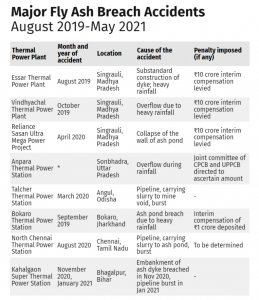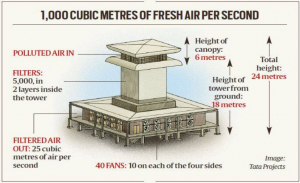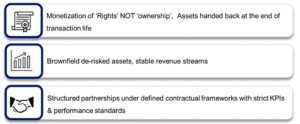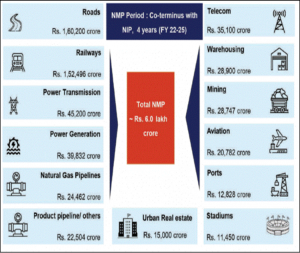INDIAN POLITY, GOVERNANCE AND SOCIAL JUSTICE
1. YUKTDHARA PORTAL
THE CONTEXT: The new portal under Bhuvan “Yuktdhara” will facilitate planning of new MGNREGA assets using Remote Sensing and GIS based information.
ANALYSIS:
- This platform will serve as a repository of assets (Geotags) created under various national rural development programmes i.e. MGNREGA, Integrated Watershed Management Programme, Per Drop More Crop and Rashtriya Krishi Vikas Yojana etc., along with field photographs.
- The word ‘Yukt’ is derived from Yojanam, the planning and ‘Dhara’ indicates the flow.
- It is a culmination of untiring joint efforts of ISRO and Ministry of Rural development made towards realising a G2G service for rural planning in support of decentralized decision making.
- The high point is that, this portal integrates wide variety of thematic layers, multi-temporal high resolution earth observation data with analysis tools. Planners will analyse previous assets under various schemes and facilitates identification of new works using online tools.
- Yuktdhara based plans will be prepared by grassroot functionary and verified by appropriate authorities for relevance and resource allocation. This would ensure quality of plan and enable a long term monitoring of the assets created over the years.
- Geo MGNREGA on Bhuvan has received wide acclaims. The Before-During-After Geotagging of assets has successfully implemented the progress based disbursement of the funds during the process of creation of rural assets. Also, a Citizen-centric Mobile Application JANMANREGA has helped rural population for providing feedback using Bhuvan services.
- The synergy of Geographic Information and Earth Observation technology has not only brought the value of location to each rural asset, but also brought in unprecedented transparency in MGNREGA programme.
Reference: PIB
2. INDIAN ARMY GRANTS COLONEL RANK TO WOMEN OFFICERS
THE CONTEXT: A Selection Board of the Indian Army cleared the way for the promotion of five women officers to Colonel (Time Scale) rank, post completion of 26 years of reckonable service.
ANALYSIS:
- This is the first time that women officers serving with the Corps of Signals, Corps of Electronic and Mechanical Engineers (EME) and the Corps of Engineers have been approved to the rank of Colonel.
- Previously, promotion to the rank of Colonel was only applicable for women officers in the Army Medical Corps (AMC), Judge Advocate General (JAG) and the Army Education Corps (AEC).
- The widening of promotion avenues to more branches of the Indian Army is a sign of increasing career opportunities for women officers.
- Combined with the decision to grant permanent commission to women officers from a majority of branches of the Indian Army, this step defines the Indian Army’s approach towards a gender-neutral Army.
Reference: PIB
ENVIRONMENT, GEOGRAPHY AND AGRICULTURE
3. GOVERNMENT CLEARED OIL PALM MISSION DESPITE RED FLAGS BY TOP FORESTRY INSTITUTE
THE CONTEXT: Recently the Union Cabinet cleared the Rs 11,040-crore National Mission on Edible Oils-Oil Palm (NMEO-OP) with a focus on growing the crop in the North-east and Andaman and Nicobar Islands due to their favourable rainfall and temperature. That clearance came in the face of objections raised by India’s top forestry research institute against introducing oil palm in biodiversity rich areas and in the absence of a detailed study it had proposed.
ANALYSIS:
- Between 1976 and 1985, nearly 16 sq km of forest land gave way to oil palm plantations in Little Andaman. In 1995, three NGOs moved the SC seeking to defend the island’s tropical rainforests and indigenous communities. The apex court formed a committee in 2001 and, based on its report, stopped monoculture or commercial plantations on the archipelago’s forest land in 2002. It also banned the introduction of exotic species
- Approached by the Andaman and Nicobar administration for relaxing its 2002 ban on plantations of exotic oil palm in the archipelago, the Supreme Court, in November 2019, had asked the Indian Council of Forestry Research & Education (ICFRE), an autonomous institute under the Environment Ministry, for its opinion.
- In January 2020, ICFRE submitted its report recommending that introduction of oil palm “should be avoided” in biodiversity rich areas, including grasslands, without detailed studies on its ecological impact.
- The push for replanting oil palm in Little Andaman came in July 2018 when Niti Aayog member Ramesh Chand visited the archipelago following a policy meeting. He recommended that the administration “should seek a review of the ban on plantation of exotic species” and commission a feasibility report for oil palm.
- Oil Palm is the source of the world’s largest consumed edible oil primarily due to its high productivity, versatility and substantial price advantage. But plantations are also blamed for inflicting widespread environmental and social damage across continents, from Cameroon to Malaysia.
- The usual oil palm planting practices — burning an area after felling forests or draining peat swamps — cause massive loss of forests and biodiversity. Whether burnt, dried or simply left to rot, dead trees and vegetation release greenhouse gases. Such rapid change in land use have also been linked to social impact.
Reference: Indian express
4. INDIA’S NEW DIRECTIVES ON SUSTAINABLE DISPOSAL OF FLY ASH MAY DO MORE HARM THAN GOOD
THE CONTEXT: According to researchers and activists, the latest government attempt to ensure the safe and sustainable disposal of fly ash could end up damaging India’s farmlands, water bodies and fragile habitats.
ANALYSIS:
- Over the last two decades, the Indian government has been issuing notifications on the disposal and utilisation of fly ash.
- Its recommendations have varied: use it to manufacture building material and in construction work and apply it as soil conditioner in farms and use it to reclaim low-lying areas and empty mines. However, over 50% of industries remain non-compliant, mostly dumping the ash in the open, in water bodies and in unlined and uncovered pits.
- As per a status report by Fly Ash Watch Group ,there have been eight major incidents involving coal ash in India between August 2019 and May this year. The Singrauli region spread across Singrauli district in Madhya Pradesh and Sonbhadra district in Uttar Pradesh accounted for half of these.
- In 2019-’20, 197 thermal plants in India generated 226 million tonnes of fly ash. And nearly 1.6 billion tonnes of it are scattered over 65,000 acres of land, as of 2019.
- Accidents happen mostly when fly ash overflows or breaks through the embankment of ash ponds where it has been dumped.
- An ash pond is designed with an embankment all around and an internal and external drainage system. It needs to be constantly monitored for safety and spillage.

Reference: Scroll
5. DELHI’S NEW SMOG TOWER
THE CONTEXT: Delhi Chief Minister inaugurated the country’s first ‘smog tower’, an experimental set up worth Rs 20 crore to purify air in a 1-km radius around the structure.
COMPONENTS OF SMOG TOWER

HOW IT WORKS?
- Polluted air is sucked in at a height of 24 m, and filtered air is released at the bottom of the tower, at a height of about 10 m from the ground.
- When the fans at the bottom of the tower operate, the negative pressure created sucks in air from the top.
- The ‘macro’ layer in the filter traps particles of 10 microns and larger, while the ‘micro’ layer filters smaller particles of around 0.3 microns.
- The downdraft method is different from the system used in China, where a 60-metre smog tower in Xian city uses an ‘updraft’ system — air is sucked in from near the ground, and is propelled upwards by heating and convection. Filtered air is released at the top of the tower.
LIKELY IMPACT
- Computational fluid dynamics modelling by IIT-Bombay suggests the tower could have an impact on the air quality up to 1 km from the tower.
- The actual impact will be assessed by IIT-Bombay and IIT-Delhi in a two-year pilot study that will also determine how the tower functions under different weather conditions, and how levels of PM2.5 vary with the flow of air.
- An automated Supervisory Control and Data Acquisition (SCADA) system in the tower will monitor air quality. Levls of PM2.5 and PM10, besides temperature and humidity, will be measured constantly, and will be displayed on a board atop the tower.
- Monitors will soon be installed at various distances from the tower to determine its impact at these distances. The project aims to provide purified air in a “localised” area.
SUPREME COURT ORDER
- In 2019, the Supreme Court directed the Central Pollution Control Board (CPCB) and the Delhi government to come up with a plan to install smog towers to combat air pollution.
- The court was hearing a matter related to air pollution in the national capital due to stubble-burning in Punjab, Haryana and Uttar Pradesh.
- IIT-Bombay then submitted a proposal for the towers to the CPCB. In January 2020, the Supreme Court directed that two towers should be installed by April as a pilot project.
- The smog tower at Connaught Place is the first of these towers. The second tower, being constructed at Anand Vihar in east Delhi with CPCB as the nodal agency, is nearing completion.
NO EVIDENCE SO FAR
- This is the first experiment with a large-scale outdoor air-purification system in India. Small smog towers have been raised in Netherlands and South Korea; larger ones have been set up in China. Experts said there isn’t enough evidence that smog towers work.
- We haven’t come across any clear data that has shown that smog towers have helped to improve the outdoor ambient air quality of a city, either in India or other parts of the world.
- There were no proven efficiency calculations on such installations. We would have to control emissions at the ground level, not create emissions and then try to clean it.
- Delhi has three smaller air purifiers (about 12 feet tall) installed by the Gautam Gambhir Foundation in Krishna Nagar, Gandhi Nagar, and Lajpat Nagar — essentially big versions of indoor air purifiers.
Reference: Indian express
6. GLOBAL EMISSIONS CAN DECLINE 10% IF REFINERIES CLEAN UP THEIR ACT
THE CONTEXT: According to the global inventory of carbon dioxide (CO2) emissions published recently in One Earth, Global cumulative emissions could be reduced by 10 per cent during 2020-2030 if refineries adopted low carbon measures.
ANALYSIS:
- The carbon measures include refineries improving their efficiency and upgrading heavy oil processing technologies. The inventory covered 1,056 refineries from 2000-2018.
- The researchers also found that emissions from the refineries were about 1.3 gigatonne (Gt) in 2018. These would increase to 16.5 Gt of CO2 from 2020-2030 if mitigation strategies were not adopted.
- The oil refining industry in 2003 witnessed a spurt in growth in China and India, directly leading to a rise in CO2 emissions. China’s refinery output increased by 11 per cent in 2003 and 12 per cent in 2004.
- In contrast, Europe witnessed a decline in the refinery industry after 2009. This was due to a decline in the demand for refined petroleum products because of the impact of the European Union’s environmental and energy policies.
- CO2 emissions from the oil refineries in China and India experienced growth between 2000 and 2018 and their contribution climbed to 16 per cent and seven per cent in 2018, from six per cent and three per cent in 2000 respectively.
- In the same period, the share of Europe and the United States fell to 17 per cent and 21 per cent in 2018, from 22 per cent and 24 per cent in 2000.
- The global oil refining industry was dominated by two types of refineries in 2018 — new refineries (less than 40 years) in China, India and West Asia and older refineries (40 years and older) in Europe, the United States and Japan.
- The refining capacity of the two types of refineries accounted for 22 per cent and 35 per cent of the total refining capacity in 2018 respectively and their CO2 emissions accounted for 22 per cent and 37 per cent of the total CO2 emissions of the oil refining industry.
- Old refineries in Japan, Europe and the United States were still emitting large amounts of CO2 in 2018 and they were unlikely to be shut down in the next few years, according to the inventory.
- Petroleum refineries are the third-largest global source of stationery greenhouse gas emissions, accounting for 40 per cent of emissions from the oil and gas supply chain.
Reference: Down to earth
INDIAN ECONOMY
7. THE NATIONAL MONETISATION PIPELINE
THE CONTEXT: Union Minister for Finance launched the asset monetisation pipeline of Central ministries and public sector entities: ‘National Monetisation Pipeline (NMP Volumes 1 & 2)’.
NATIONAL MONETISATION PIPELINE: AN INTRODUCTION
- Union Budget 2021-22 has identified monetisation of operating public infrastructure assets as a key means for sustainable infrastructure financing.
- Towards this, the Budget provided for preparation of a ‘National Monetisation Pipeline (NMP)’ of potential brownfield infrastructure assets. NITI Aayog in consultation with infra line ministries has prepared the report on NMP.
- NMP aims to provide a medium term roadmap of the programme for public asset owners; along with visibility on potential assets to private sector. Report on NMP has been organised into two volumes.
- Volume I is structured as a guidance book, detailing the conceptual approaches and potential models for asset monetisation.
- Volume II is the actual roadmap for monetisation, including the pipeline of core infrastructure assets under Central Govt.
FRAMEWORK
- The pipeline has been prepared based on inputs and consultations from respective line ministries and departments, along with the assessment of total asset base available therein. Monetization through disinvestment and monetization of non-core assets have not been included in the NMP.
- Currently, only assets of central government line ministries and CPSEs in infrastructure sectors have been included. Process of coordination and collation of asset pipeline from states is currently ongoing and the same is envisaged to be included in due course.
- The framework for monetisation of core asset monetisation has three key imperatives.

- This includes selection of de-risked and brownfield assets with stable revenue generation profile with the overall transaction structured around revenue rights. The primary ownership of the assets under these structures, hence, continues to be with the Government with the framework envisaging hand back of assets to the public authority at the end of transaction life.
ESTIMATED POTENTIAL
- Considering that infrastructure creation is inextricably linked to monetisation, the period for NMP has been decided so as to be co-terminus with balance period under National Infrastructure Pipeline (NIP).
- The aggregate asset pipeline under NMP over the four-year period, FY 2022-2025, is indicatively valued at Rs 6.0 lakh crore. The estimated value corresponds to ~14% of the proposed outlay for Centre under NIP (Rs 43 lakh crore).
- This includes more than 12 line ministries and more than 20 asset classes. The sectors included are roads, ports, airports, railways, warehousing, gas & product pipeline, power generation and transmission, mining, telecom, stadium, hospitality and housing. Sector wise Monetisation Pipeline over FY 2022-25 (Rs crore)

- The top 5 sectors (by estimated value) capture ~83% of the aggregate pipeline value. These top 5 sectors include: Roads (27%) followed by Railways (25%), Power (15%), oil & gas pipelines (8%) and Telecom (6%).
- In terms of annual phasing by value, 15% of assets with an indicative value of Rs 0.88 lakh crore are envisaged to be rolled out in the current financial year (FY 2021-22). However, the aggregate as well as year on year value under NMP is only an indicative value with the actual realization for public assets depending on the timing, transaction structuring, investor interest etc.
- Indicative value of the monetisation pipeline year-wise (Rs crore).

- The assets and transactions identified under the NMP are expected to be rolled out through a range of instruments. These include direct contractual instruments such as public private partnership concessions and capital market instruments such as Infrastructure Investment Trusts (InvIT) among others.
- The choice of instrument will be determined by the sector, nature of asset, timing of transactions (including market considerations), target investor profile and the level of operational/investment control envisaged to be retained by the asset owner etc.
- The monetisation value that is expected to be realised by the public asset owner through the asset monetisation process, may either be in form of upfront accruals or by way of private sector investment. The potential value assessed under NMP is only an indicative high level estimate based on thumb rules. This is based on various approaches such as market or cost or book or enterprise value etc. as applicable and available for respective sectors.
IMPLEMENTATION & MONITORING MECHANISM
- As an overall strategy, significant share of the asset base will remain with the government.
- The programme is envisaged to be supported through necessary policy and regulatory interventions by the Government in order to ensure an efficient and effective process of asset monetisation. These will include streamlining operational modalities, encouraging investor participation and facilitating commercial efficiency, among others. Real time monitoring will be undertaken through the asset monetisation dashboard, as envisaged under Union Budget 2021-22, to be rolled out shortly.
- The end objective of this initiative to enable ‘Infrastructure Creation through Monetisation’ wherein the public and private sector collaborate, each excelling in their core areas of competence, so as to deliver socio-economic growth and quality of life to the country’s citizens.
Reference: PIB
8. INDIA AND ADB SIGN $500 MILLION LOAN TO EXPAND METRO RAIL NETWORK IN BENGALURU
THE CONTEXT: The Government of India and the Asian Development Bank (ADB) today signed a $500 million loan to expand the metro rail network in Bengaluru with construction of two new metro lines totaling 56 km in length.
ANALYSIS:
- The project supports urban transformation of Bengaluru City into a more livable and sustainable city through support to urban public transport and urban development with concepts of transit-oriented development (TOD) and multi-modal integration (MMI).
- The project will bring various benefits including road de-congestion, better urban livability and environmental improvement.
- TOD-based urban development model will target realigning growth and increase the city’s economic productivity by creating higher density, compact, mixed use, mixed income, safe, and resource-efficient and inclusive neighborhoods.
- TOD also aims to raise land values along these corridors, generating capital revenues for the state government to meet the city’s long-term investment needs.
- MMI will aim to provide people-oriented, environment-friendly solutions and a safe, total mobility solution for all Bangalore residents through the seamless integration of different modes of public transport.
- The project will construct two new metro lines, mostly elevated, along Outer Ring Road and National Highway 44 between Central Silk Board and Kempegowda International Airport with 30 stations.
- This will help decongest traffic in the city area and provide seamless connectivity to the airport. The needs of vulnerable groups, such as the elderly, women, children, and differently abled persons, will be reflected on the metro facilities.
- An additional $2 million technical assistance grant from ADB will help the state government formulate urban development plans and their implementing frameworks, focusing on TOD and multimodal integration.
- The grant will also be used to strengthen the capacity of the Bangalore Metro Rail Corporation Limited and other state agencies to implement these initiatives.
- ADB is committed to achieving a prosperous, inclusive, resilient, and sustainable Asia and the Pacific, while sustaining its efforts to eradicate extreme poverty. Established in 1966, it is owned by 68 members—49 from the region.
Reference: PIB
Q 1. Consider the following statements:
1. India’s eastern coast is more vulnerable to tropical cyclones as compared to western coast.
2. In 2021, Cyclone Tauktae hit the eastern coast of India while Cyclone Yaas hit the western Coast of India.
Which of the statements given above is/are correct?
a) 1 only
b) 2 only
c) Both 1 and 2
d) Neither 1 nor 2
Q 2. Recently in news, “Yuktdhara” Portal is related to:
a) Education
b) Rural Development
c) Health
d) Refugees
ANSWER FOR AUGUST 20, 2021 PRELIMS PRACTICE QUESTIONS (REFER RELEVANT ARTICLE)
Q.1 ANSWER: A
Explanation:
- Statement 1 is correct: Guam is an organized, unincorporated territory of the United States in the Micronesia subregion of the western Pacific Ocean.
- Statement 2 is incorrect: It is the largest and southernmost of the Mariana Islands and the largest island in Micronesia. Guam’s capital is Hagåtña.
Answer: A
Explanation:
• The barasingha (Rucervus duvaucelii), also called swamp deer.
• In Assamese, barasingha is called dolhorina; dol meaning swamp.
• Habitat: Swamp deer occur in the Kanha National Park of Madhya Pradesh, in only 6 localities in Uttar Pradesh. A few survive in Assam’s Kaziranga and Manas National Parks.
• In 2005, a small population of about 320 individuals was discovered in the Jhilmil Jheel
- Conservation Reserve in Haridwar district in Uttarakhand on the east bank of the Ganges.
- Threats: Poaching for antlers and meat, wetlands converted and used for agriculture.
- Conservation:
• listed on CITES Appendix I.
• Schedule I of the Wildlife Protection Act of 1972.
• IUCN status- Vulnerable
Spread the Word




